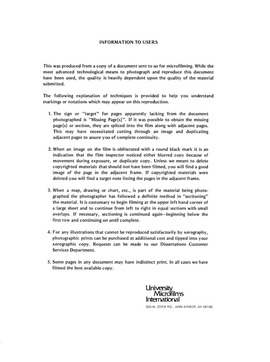| dc.contributor.author | Adkins, Harvey John, | en_US |
| dc.date.accessioned | 2013-08-16T12:28:28Z | |
| dc.date.available | 2013-08-16T12:28:28Z | |
| dc.date.issued | 1982 | en_US |
| dc.identifier.uri | https://hdl.handle.net/11244/4946 | |
| dc.description.abstract | This research shows that association with EF-Tu(.)GTP induces a conformational change in the aa-tRNA. This may be the primary means by which EF-Tu promotes protein biosynthesis. Topological data from this research, when combined with results from other researchers, indicate that the entire anticodon stem, as well as the corner region of the aa-tRNA are available to interact directly with ribosomal components during the recognition process. | en_US |
| dc.description.abstract | Finally, these studies provide preliminary evidence that there is a conformational difference between unacylated tRNA and aa-tRNA. These two species differed both in their affinity for ethidium and in the iodide ion quenching efficiency of a fluorescent dye covalently attached to 4-thiouridine. | en_US |
| dc.description.abstract | Important topological information was provided by collisional quenching and ethidium binding studies. In the fluorescence quenching experiments, the intensity of the fluorescein emission was quenched whether or not Phe-tRNA('Phe)-F('8) was complexed with EF-Tu(.)GTP. In the ethidium binding experiments, it was shown that the strong binding site could be filled even when the aa-tRNA was associated with EF-Tu(.)GTP. Thus, the region near 4-thiouridine is not physically covered by EF-Tu in the ternary complex. | en_US |
| dc.description.abstract | E. coli tRNA('Phe) was labeled with fluorescein. The dye was covalently attached (one dye per tRNA) to the 4-thiouridine base at position #8. The attachment of the dye did not significantly alter the ability of the modified Phe-tRNA('Phe)-F('8) to associate with EF-Tu(.)GTP. | en_US |
| dc.description.abstract | The emission intensity of Phe-tRNA('Phe)-F('8) increased substantially (28%) when the aa-tRNA was complexed with EF-Tu(.)GTP. Collisional quenching of the fluorescence of Phe-tRNA('Phe)-F('8) in the ternary complex demonstrated that the fluorescence change was not due to a direct interaction between the protein and the fluorescent dye moiety. More likely, there was a conformation change in the corner region of the aa-tRNA upon ternary complex formation. | en_US |
| dc.description.abstract | Upon ternary complex formation the binding of ethidium to unmodified, unfractionated aa-tRNA is apparently inhibited, even though the binding site is not blocked by the protein. This observation is consistent with the putative change in conformation of the aa-tRNA suggested by the above results. | en_US |
| dc.description.abstract | The interaction of aa-tRNA with elongation factor Tu(.)GTP was investigated using site-specific fluorescent probes located near the corner region of the aa-tRNA. | en_US |
| dc.format.extent | viii, 138 leaves : | en_US |
| dc.subject | Chemistry, Biochemistry. | en_US |
| dc.title | An investigation of the interaction of aminoacy-transfer RNA with elongation factor Tu using site-specific fluorescent probes. | en_US |
| dc.type | Thesis | en_US |
| dc.thesis.degree | Ph.D. | en_US |
| dc.thesis.degreeDiscipline | Department of Microbiology and Plant Biology | en_US |
| dc.note | Source: Dissertation Abstracts International, Volume: 43-02, Section: B, page: 0403. | en_US |
| ou.identifier | (UMI)AAI8215780 | en_US |
| ou.group | College of Arts and Sciences::Department of Microbiology and Plant Biology | |
